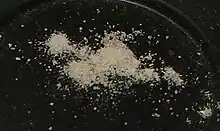Antimony oxychloride
Antimony oxychloride, known since the 15th century, has been known by a plethora of alchemical names. Since the compound functions as both an emetic and a laxative, it was originally used as a purgative.
 | |
| Names | |
|---|---|
| IUPAC name
antimony oxide chloride | |
| Identifiers | |
| |
3D model (JSmol) |
|
| ChemSpider | |
| ECHA InfoCard | 100.029.308 |
| EC Number |
|
PubChem CID |
|
| UNII | |
CompTox Dashboard (EPA) |
|
| |
| |
| Properties | |
| SbOCl | |
| Molar mass | 173.21 g/mol |
| Melting point | 280 °C (536 °F; 553 K) |
| insoluble | |
| Related compounds | |
Related compounds |
|
Except where otherwise noted, data are given for materials in their standard state (at 25 °C [77 °F], 100 kPa).
Infobox references | |
History
Its production was first described by Basil Valentine in Currus Triumphalis Antimonii. In 1659, Johann Rudolf Glauber gave a relatively exact chemical interpretation of the reaction.
Vittorio Algarotti introduced the substance into medicine, and derivatives of his name (algarot, algoroth) were associated with this compound for many years.
The exact composition was unknown for a very long time. The suggestion of SbOCl being a mixture of antimony trichloride and antimony oxide or pure SbOCl were raised. Today the hydrolysis of antimony trichloride is understood; first the SbOCl oxychloride is formed which later forms Sb4O5Cl2.
Natural occurrence
Neither SbOCl nor the latter compound occur naturally. However, onoratoite is a known Sb-O-Cl mineral, its composition being Sb8Cl2O11.[2][3][4][5][6]
Alternative historical names
- mercurius vitæ ("mercury of life")
- powder of algaroth[7]
- algarel
- Pulvis angelicus.
Synthesis
Dissolving antimony trichloride in water yields antimony oxychloride:
- SbCl3 + H2O → SbOCl + 2 HCl
References
- Nurgaliev, B. Z.; Popovkin, B. A.; Novoselova, A. V. (1981). "Physiochemical analysis of antimony trioxide–antimony trichloride, antimony trioxide–antimony tribromide systems". Zhurnal Neorganicheskoi Khimii. 26 (4): 1043–1047.
- Mayerová, Zuzana; Johnsson, Mats; Lidin, Sven (2006). "The structure of onoratoite, (, Br) revisited". Solid State Sciences. 8 (7): 849–854. doi:10.1016/j.solidstatesciences.2006.04.010. ISSN 1293-2558.
- Menchetti, S.; Sabelli, C.; Trosti-Ferroni, R. (1984). "The structures of onoratoite, Sb8O11Cl2 and Sb8O11Cl2.6H2O". Acta Crystallographica Section C. 40 (9): 1506–1510. doi:10.1107/S0108270184008532. ISSN 0108-2701.
- Belluomini, G.; Fornaseri, M.; Nicoletti, M. (2018). "Onoratoite, a new antimony oxychloride, from Cetine di Cotorniano, Rosia (Siena, Italy)". Mineralogical Magazine and Journal of the Mineralogical Society. 36 (284): 1037–1044. doi:10.1180/minmag.1968.036.284.01. ISSN 0369-0148.
- Roper, Adam J.; Leverett, Peter; Murphy, Timothy D.; Williams, Peter A. (2018). "The stability of onoratoite, Sb8O11Cl2, in the supergene environment". Mineralogical Magazine. 78 (7): 1671–1675. doi:10.1180/minmag.2014.078.7.10. ISSN 0026-461X. S2CID 99331237.
- Lidin, Sven; Johnsson, Mats; Hugonin, Zuzana (2009). "Modulations in the onoratoite system". Solid State Sciences. 11 (7): 1198–1205. Bibcode:2009SSSci..11.1198L. doi:10.1016/j.solidstatesciences.2009.03.009. ISSN 1293-2558.
- Lavoisier, Antoine-Laurent de (1743-1794). Auteur du texte (1789). Traité élémentaire de chimie, présenté dans un ordre nouveau, et d'après les découvertes modernes; Avec figures; Par M. Lavoisier,... [Treatise Elementary of Chemistry, Presented in a New Order, and after the Discoveries Modern; with Figures; by M. Lavoisier, ... (author of text)] (in French). France: A Paris, chez Cuchet, libraire, rue & hôtel Serpente. M. DCC. LXXXIX. Sous le privilège de l'Académie des sciences & de la Société royale de médecine. pp. Préliminaire XXV, "poudre d'algaroth".
Further reading
- Chambers, Ephraim (1728). "Cyclopaedia, or, An universal dictionary of arts and sciences". Retrieved 25 May 2013.
- José Rodríguez has published a complete study devoted to the commercial network of chemical medicines developed by Vittorio Algarotti: The First Commercial Network of a Chymical Medicine:
- Van Bemmelen, J. M.; Meerburg, P. A.; Noodt, U. Huber (1902). "Das System (SbCl3-HCl-H2O)". Zeitschrift für Anorganische Chemie. 33: 272–310. doi:10.1002/zaac.19030330137.
- Lémery, Nicolas (1707). Traité de l'antimoine.
- Soukup, Rudolf Werner (1999). "Chemiehistorische Experimente: Erze als Ausgangsprodukte für die Herstellung von Arzneimitteln". Chemkon. 6 (4): 171–177. doi:10.1002/ckon.19990060403.
- Särnstrand, C. (1978). "The crystal structure of antimony(III) chloride oxide Sb4O5Cl2". Acta Crystallographica Section B. 34 (8): 2402–2407. doi:10.1107/S056774087800833X.
- Hentz, F. C.; Long, G. G. (1975). "Synthesis, properties, and hydrolysis of antimony trichloride". Journal of Chemical Education. 52 (3): 189. Bibcode:1975JChEd..52..189H. doi:10.1021/ed052p189.
- Edstrand, Maja; Brodersen, Rolf; Sillén, Lars Gunnar; Linnasalmi, Annikki; Laukkanen, Pentti (1947). "On the Crystal Structure of the Antimony Oxychloride Sb4O5Cl2 and Isomorphous Oxybromide". Acta Chemica Scandinavica. 1: 178–203. doi:10.3891/acta.chem.scand.01-0178.
- Schaeffer, L. (1869). "VI. Ueber krystallisirtes Algarothpulver und Antimonoxychlorür". Annalen der Chemie und Pharmacie. 152 (3): 314–318. doi:10.1002/jlac.18691520307.
- "Hydrolysis of Antimony(III)-Hydrochloric Acid Solution at 25°C" (PDF). Archived from the original (PDF) on 23 April 2021. Retrieved 25 May 2013.
{{cite journal}}: Cite journal requires|journal=(help) - Peligot, M.E. (1847). "On the preparation and composition of the salts of antimony". Philosophical Magazine. Series 3. 31 (207): 230–233. doi:10.1080/14786444708645830.
- Moscardo, Lodovico (1668). Historia di Verona. Rossi. p. 441. Retrieved 25 May 2013.
- Dehnicke, Kurt (1961). "Über Antimon(V)-oxidchloride". Zeitschrift für Anorganische und Allgemeine Chemie (in German). 312 (5–6): 237–243. doi:10.1002/zaac.19613120503.